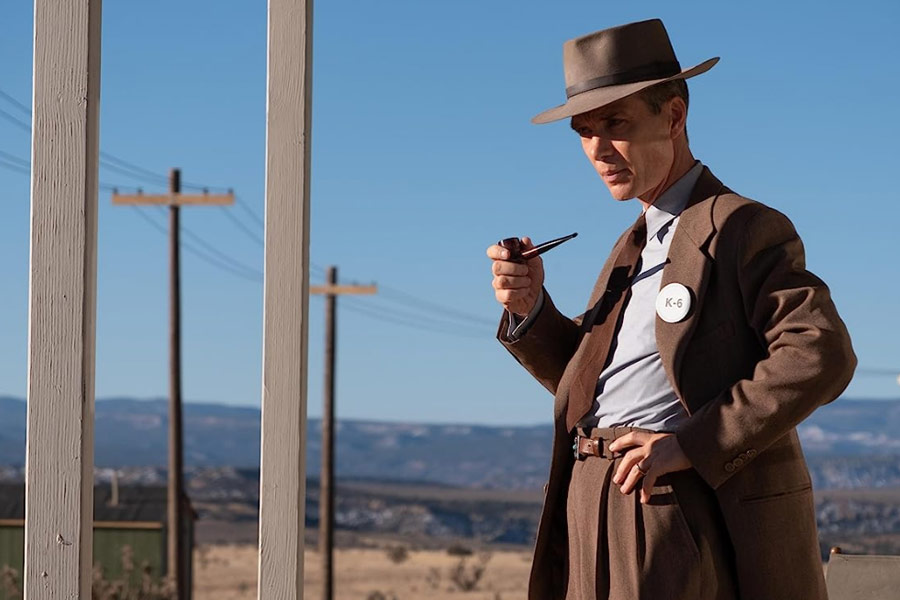Oppenheimer unfurls like the research subject of its protagonist — parts colliding, pushing and pulling to unleash the story of a tragic genius. Filmmaker Christopher Nolan even titles the two timelines of the film ‘Fission’ and ‘Fusion’, building the narrative of the coming together of the atomic bomb and the effect it had, not just on protagonist J. Robert Oppenheimer, but also the scientific and political fallout. Oppenheimer is as much a tale of ‘the father of the atomic bomb’ as it is about strife between science and politics and about the human psyche.
In true Nolan style, the slightly over three-hour film doesn’t follow a linear timeline. It opens post the Hiroshima-Nagasaki bombings with Oppenheimer’s security clearance renewal hearing inside a nondescript room. We don’t stay there long, cutting quickly back to a young Oppenheimer — a chillingly blue-eyed Cillian Murphy — plagued by visions of possibilities in quantum physics, and continue at a fast pace through his formative years. His years as a student, meeting the great minds of physics in Europe, his appointment to American institutions, his role in introducing quantum physics to the US curricula, his dalliance with unionisation and the communist party, his romantic affairs, professional friendships, his appointment as the director of Los Alamos project, the controversies and the anti-communist attacks.
Shot in vivid colour, this Fission timeline led by Murphy is intercut with the high-contrast black-and-white Fusion timeline that is led by Robert Downey Jr., who plays Lewis Strauss, a former chairman of the Atomic Energy Commission who is at a different hearing, that of his acceptance into the Eisenhower Cabinet as Secretary of Commerce, a strand of storytelling that becomes clearer in its impact on the Fission timeline as the story progresses. Yes, it is not easy, but it is a Nolan film after all. And neither the storytelling nor the subject matter of the story being told is easy.
Nolan masterfully captures the excitement and fervour of the intellectual circuit of the time, the push and pull of scientific commitment and morality, of humanity and political ambitions and the pre-Cold War paranoia. And at the centre of all this is Murphy, who is phenomenal in his portrayal of a complex and layered man — an academic rake, a genius scientist, a charming public figure, a man who holds things close to his chest, a man hailed as a war hero who is racked by guilt about the bombings of Hiroshima and Nagasaki and who tries to atone for it by being a martyr.
Shot in IMAX, the camera is unforgiving in its focus on Murphy’s face, documenting all the emotions raging through him at all times. Murphy, on his part, is very much up to the task of such intense scrutiny. Also phenomenal is Robert Downey Jr., who is all but unrecognisable as Oppenheimer’s personal and political nemesis, a man whose hubris becomes his own downfall.
With a star-studded cameo list, Oppenheimer sometimes tips into the absurd, especially with roles played by Rami Malek, Kenneth Branagh and Gary Oldman, who are on screen for very little time. Emily Blunt as Oppenheimer’s wife Kitty almost feels wasted in the role until one fiery exchange towards the end of the film which makes her presence worthwhile.
Florence Pugh as a firebrand, if unstable, communist activist and Oppenheimer’s romantic interest Jean Tatlock is the only other memorable female character in an otherwise male-dominated film. Pugh and Murphy are also part of a first for Nolan — a sex scene, and nudity.
Nolan’s ability to weave together storytelling, cinematography and auditory experience (created by the tremendously talented Ludwig Goransson) is highlighted throughout the film but nowhere as much as during the Trinity test (recreated by Nolan’s team, without CGI) where the blast happens in claustrophobic silence, making the audience live the tension, the awe, the achievement and the horror of it all.
The film goes into detail about the building of the atomic bombs but it doesn’t show the actual bombings or the destruction they result in. The horror of it lives on through the imagery of Oppenheimer’s mind that pictures raindrops like bombs, a charred body he imagines stepping on, a girl with her skin peeling off, and through dialogues. It’s imagery that you can’t shake off as you grapple with coming to terms with the role this man of science has played in setting off a ‘never-ending chain reaction’ that might just destroy the world.
Oppenheimer, the most serious film that Nolan has made and perhaps his best yet, is a masterpiece that will keep you reeling long after the images of imagined horror fade from the screen.











